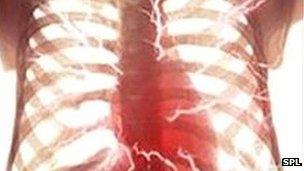Q&A: Coronary stenting
- Published

A coronary stent is used to treat coronary heart disease and angina.
The Duke of Edinburgh has undergone treatment for a blocked coronary artery at Papworth Hospital, Cambridge, after complaining of chest pains.
Buckingham Palace has confirmed that Prince Philip, 90, underwent an "invasive procedure of coronary stenting", a type of angioplasty. So what exactly is that and why would it be done?
What is an angioplasty?
It is a procedure to unblock a coronary artery. These arteries supply the heart muscles with blood, which they need to stay healthy and functional like any other organ. If the heart muscle is damaged, it impairs the ability of the heart to pump blood around the body.
Under local anaesthetic, a small balloon is inserted with a 2mm-diameter tube via an artery in the groin or arm and guided to the blockage.
Once in place, the balloon is inflated. Dr Simon Davies, consultant interventional cardiologist at the Royal Brompton Hospital in London, said: "That forces the material that is blocking the artery outwards and then gets the blood flowing down the artery again.
"The stent is like a little metal sleeve fitted over the balloon when it is blown up. This metallic sleeve is opened up and then when the balloon is deflated and withdrawn the stent stays behind."
Why would someone be given a stent?
The British Heart Foundation says coronary angioplasty and stents are used to treat coronary heart disease and severe chest pain, known as angina.
The procedure can help relieve angina symptoms and is sometimes used as an emergency treatment for people who have had a heart attack or unstable angina - that which comes on with less physical activity or even while you are resting.
Dr Davies said that when a person suffers chest pains it can - but does not necessarily - mean that "one or more of the coronary arteries is badly narrowed or perhaps blocked".
In serious cases, it can mean that blood is not passing through that artery. This means the muscle is starved of oxygen and may be in danger of dying - in other words the person could be on the verge of, or having, heart attack, Dr Davies said.
What are the risks of an angioplasty?
It is a commonly used procedure and the chances of recovery are generally good. However, consultant surgeon Shyam Kolvekar said the risks of the procedure increase with age.
With regards to a 90-year-old, he said: "At this age the arteries are quite thick and you may not even be able to pass a needle or plastic tube through it and that becomes quite difficult.
"The balloon may not even work to open this artery and the stent may not be able to deploy. So those are the risks at that age but it is one of the best treatments at that age too."